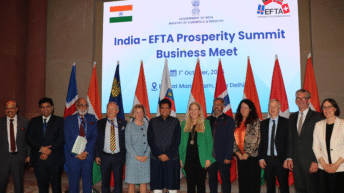
Tariffs may cut India’s exports, but they also cut through the notion that external pressure can override India’s strategic autonomy. History demonstrates that imposing trade barriers, sanctions or technology denial has rarely produced the intended results with India. Such actions have often led to innovation and long-term resilience.
The United States, as a global power, has frequently influenced New Delhi’s growth trajectory. Trump’s 2025 tariffs fit this pattern. While this would temporarily hinder India’s export growth, it is also a reminder of the fact that India’s path is not determined by limitations but by its vision and creativity.
One of the most dramatic examples of U.S. pressure backfiring was the case of India’s nuclear tests. In response to the Pokhran-I test in 1974 the U.S. ceased the nuclear engagement, terminated uranium shipments to Tarapur Atomic Power Station, and discontinued technology transfers and began to coordinate the formation of the Nuclear Suppliers Group (NSG) to ostracize India. After more sanctions followed in response to the 1998 Pokhran-II tests, the then Prime Minister Atal Bihari Vajpayee stated, “Sanctions cannot and will not hurt us”. India unequivocally became a nuclear power and in 2008 the U.S., after many years of determined policy of isolating and embargoing India, was compelled to begin negotiations with New Delhi on the India-U.S. Civil nuclear deal.
Space Technology Refusal: ISRO’s Rise
The space domain offers a vivid example of the ways in which technologically deprivation can lead to new forms of innovation. In the 1990s, the U.S. effectively demanded that Russia halt the sale of cryogenic engines. The Indian space program even faced covert attempts to sabotage its progress, including the targeting and arrest of key personnel.
Such adversity forced Indian scientists to develop the engines indigenously, marking India’s entry into the elite club of nations with heavy lift capabilities by the successful launch of GSLV D5. Today, ISRO’s accomplishments have included soft-landing on the Moon’s South Pole via Chandrayaan-3, and launching of over hundred satellites in a single mission, at a fraction of the cost of U.S. attempts.
Similarly, during the Kargil War in 1999, India was denied access to GPS data in war zones. This created impetus for an independent satellite navigation system leading to the Indian Regional Navigation Satellite System (IRNSS). The IRNSS, now known as NavIC, provides accurate navigational facility across India and beyond, while ensuring strategic autonomy in national security.
From Dependency to Surplus
In the 1960s the U.S. tried to use PL-480 food aid as a means of developing an agricultural dependency, however the attempts backfired as India gradually embraced self-reliance in food production. The economy was transformed from a food deficit to a food surplus via the Green Revolution, pioneered by Dr. M.S. Swaminathan, with support from Norman Borlaug. The production of foodgrains multiplied from 50 million tons in 1950-51 to 130 million tons in 1980. As a result of this approach, by the early 1970s India became self-sufficient in food production, indicating that strategic resilience can be developed in essential sectors like agriculture.
A similar trajectory can be seen in the US defence technology restrictions after 1998. Projects like the Light Combat Aircraft (LCA) have been developed through indigenous expertise. Today the BrahMos missile, advanced artillery system, Integrated Air Defence Weapon System (IADWS) developed either indigenously or in collaboration are some of the examples of domestic capacity. Defence production has touched ₹1.27 lakh crore in FY 2023-24, a 174% rise since 2014-15, alongside a sharp expansion in exports.
Trump’s 2025 Tariffs: History Repeating
The situation mirrors itself in Trump’s 50% tariffs on Indian goods. Being temporarily disruptive for sectors like textile, gem, jewelry and chemical manufacturing, they are also fuel for transformation.
India is currently addressing this by strategically increasing textile exports to 40 countries including UK, Japan, Russia but under a one “Brand India” vision. The Export Promotion Councils and Indian Missions abroad have been tasked with identifying the high demand products in these regions and on the basis of product mapping, design the export strategy. India can tap into these markets with the products like textiles, processed food, cotton, chemicals, and pharmaceuticals where it has a Revealed Comparative Advantage.
Taking into account a specific high-employment potential sector like textiles, India is a sixth-largest exporter with a 4.1% global share in a market worth over $1 trillion Therefore, there lies an opportunity for India to increase its export share through diversified export promotion strategy and upgrading value chains.
The area of pharmaceuticals serves as another important example. India exports generics to over 200 countries with 20% global share. The biosimilar drug market in particular is expected to boom, increasing exports from $0.8 billion at present to $4.2 billion by 2030, and potentially touch $30-35 billion by 2047.
Meanwhile the recently signed India-UK Comprehensive Economic and Trade Agreement (CETA), a free trade agreement, is a new dawn as far as opportunities are concerned across wide range of sectors. Overall, nearly 99% of Indian products within tariff lines have been cleared for duty- free access including agriculture, processed food, textile, engineering goods, chemical, pharmaceutical, marine products and electronics among other commodities. This not only enhances competitiveness but also reduces compliance costs, and boosts access to the UK market.
From Chips to Missiles: India’s Strategy for High-Complexity Industries
Cesar A. Hidalgo and Ricardo Hausmann, from MIT and Harvard University, respectively, have provided us with an effective method to gauge product’s sophistication through their Product Complexity Index or PCI. The concept was first presented in their 2009 paper and originates from the premise that economic development is linked to the capacity of a country to generate and export products of a higher level of complexity.
High PCI products are “products of complexity” that require networks of technological know-how and industrial research. Semiconductors production, for instance, need skilled engineers, advanced equipment, and cutting-edge research and design. Other examples of high PCI goods can be advanced pharmaceuticals or aerospace components that require very precision machining and complex software systems. The capacity-building in these activities is a very steep curve for most countries if they have not been doing this for years. However, once learned it is versatile and advantageous. India’s manufacturing needs to align with the policy of producing complex and high-value goods.
The Semiconductor Mission (ISM 2.0) is a step in the right direction. An upgraded version of the 2021 scheme, ISM.2.0 looks at further bolstering domestic manufacturing of chips and expanding the scope to include compound semiconductors, and design, and double the total outlay to around ₹1.7 lakh crore. Existing PLI Schemes in high PCI areas such as electronics and semiconductors (including advanced chipsets and components), Telecom equipment(5G) can support domestic production in high tech sectors, provide incentives, introduce scale and increase exports.
Apart from this, India is implementing an ambitious program to increase Rare Earths & High-Performance Magnet production for an investment totaling ₹7,300. This is critical in the case of electric vehicles, as well as wind turbines. There is a support for capital and operational expenditure and a target of reaching 6,000 tons of production by the year 2030, in order to cater to the increasing demand in India, and reduce dependency on China.
When it comes to high-PCI goods, the National Defence Industrial Policy is focusing on increasing the export of India’s high-technology defence products. From BrahMos missiles, Akash air defence systems, and HAL Tejas aircraft to Pinaka multi-launch rocket systems, advanced simulators, and radar and surveillance systems, India is either exporting these platforms or engaged in discussions with several countries that have expressed strong interest in acquiring them.
Exploring CPTPP: Strategic Diversification
With the tough stance on tariffs, U.S. has pushed India to look for trade diversification and mega trade agreements such as the Comprehensive and Progressive Agreement for Trans-Pacific Partnership (CPTPP). It is a free trade agreement between 12 countries: Australia, Brunei, Canada, Chile, Japan, Malaysia, Mexico, New Zealand, Peru, Singapore, the United Kingdom, and Vietnam. CPTPP’s combined GDP is $13 trillion and the associated regulatory standards can provide Indian businesses new markets at favourable tariff levels. While joining CPTPP could be difficult to acclimatize to, especially for small and medium enterprises, it falls in line with India’s “China Plus One” trade strategy and could potentially have advantage in terms of technology transfer and advanced supply chains.
India has already opted out of Regional Comprehensive Economic Partnership (RCEP) due to concerns over potential risks, including increased exposure to Chinese goods, vulnerabilities in sensitive sectors and the possibility of competitive disadvantage. In contrast, since the CPTPP doesn’t currently include China, such deeper risks can be mitigated and there would be less competitive pressure from Chinese imports under this framework.
Mission: Possible
India’s counter-strategy to global economic pressure involves lowering domestic GST rates, allowing for strategic currency depreciation, diversifying exports, ramping up defence production and high-tech manufacturing under PLI schemes. The lesson is clear: sustained progress cannot be dependent on external actors. True resilience is forged in adversity, shaped by challenges and guided by a firm commitment to maintain strategic independence while engaging pragmatically with the world. This is a difficult mission but not mission impossible.






Add comment